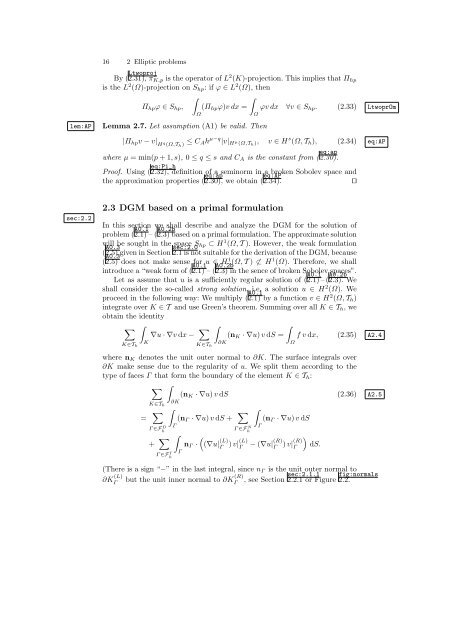2 DGM for elliptic problems
2 DGM for elliptic problems
2 DGM for elliptic problems
You also want an ePaper? Increase the reach of your titles
YUMPU automatically turns print PDFs into web optimized ePapers that Google loves.
lem:AP<br />
16 2 Elliptic <strong>problems</strong><br />
By ( 2.31), Ltwoproj π K,p is the operator of L 2 (K)-projection. This implies that Π hp<br />
is the L 2 (Ω)-projection on S hp : if ϕ ∈ L 2 (Ω), then<br />
∫<br />
∫<br />
Π hp ϕ ∈ S hp , (Π hp ϕ)v dx = ϕv dx ∀v ∈ S hp . (2.33) LtwoprOm<br />
Lemma 2.7. Let assumption (A1) be valid. Then<br />
Ω<br />
Ω<br />
|Π hp v − v| Hq (Ω,T h ) ≤ C Ah µ−q |v| Hµ (Ω,T h ), v ∈ H s (Ω, T h ), (2.34) eq:AP<br />
where µ = min(p + 1,s), 0 ≤ q ≤ s and C A is the constant from ( 2.30).<br />
eq:ap<br />
Proof. Using ( 2.32), eq:Pi_h definition of a seminorm in a broken Sobolev space and<br />
the approximation properties ( 2.30), eq:ap we obtain ( 2.34). eq:AP<br />
⊓⊔<br />
sec:2.2<br />
2.3 <strong>DGM</strong> based on a primal <strong>for</strong>mulation<br />
In this section we shall describe and analyze the <strong>DGM</strong> <strong>for</strong> the solution of<br />
problem ( 2.1) A0.1 – ( 2.3) A0.2b based on a primal <strong>for</strong>mulation. The approximate solution<br />
will be sought in the space S hp ⊂ H 1 (Ω, T ). However, the weak <strong>for</strong>mulation<br />
( 2.5) A0.3 given in Section 2.1 sec:2.0 is not suitable <strong>for</strong> the derivation of the <strong>DGM</strong>, because<br />
( 2.5) A0.3 does not make sense <strong>for</strong> u ∈ H 1 (Ω, T ) ⊄ H 1 (Ω). There<strong>for</strong>e, we shall<br />
introduce a “weak <strong>for</strong>m of ( 2.1) A0.1 – ( 2.3) A0.2b in the sence of broken Sobolev spaces”.<br />
Let as assume that u is a sufficiently regular solution of ( 2.1) A0.1 – ( 2.3). A0.2b We<br />
shall consider the so-called strong solution, i.e. a solution u ∈ H 2 (Ω). We<br />
proceed in the following way: We multiply ( 2.1) A0.1 by a function v ∈ H 2 (Ω, T h )<br />
integrate over K ∈ T and use Green’s theorem. Summing over all K ∈ T h , we<br />
obtain the identity<br />
∑<br />
∇u · ∇v dx − ∑<br />
∫<br />
(n K · ∇u)v dS = f v dx, (2.35) A2.4<br />
K∈T h<br />
∫K<br />
K∈T h<br />
∫∂K<br />
where n K denotes the unit outer normal to ∂K. The surface integrals over<br />
∂K make sense due to the regularity of u. We split them according to the<br />
type of faces Γ that <strong>for</strong>m the boundary of the element K ∈ T h :<br />
∑<br />
K∈T h<br />
∫∂K<br />
= ∑<br />
Γ ∈F D h<br />
+ ∑<br />
∫<br />
Γ ∈F I h<br />
Γ<br />
∫<br />
(n K · ∇u)v dS (2.36) A2.5<br />
(n Γ · ∇u)v dS + ∑<br />
Γ<br />
(<br />
n Γ ·<br />
Γ ∈F N h<br />
(∇u| (L)<br />
Γ<br />
)v|(L) Γ<br />
∫<br />
Γ<br />
Ω<br />
(n Γ · ∇u)v dS<br />
− (∇u|(R) Γ<br />
)v|(R) Γ<br />
)<br />
dS.<br />
(There is a sign “−” in the last integral, since n Γ is the unit outer normal to<br />
but the unit inner normal to ∂K (R) sec:2.1.1<br />
Γ<br />
, see Section 2.2.1 or Figure 2.2.<br />
fig:normals<br />
∂K (L)<br />
Γ
















